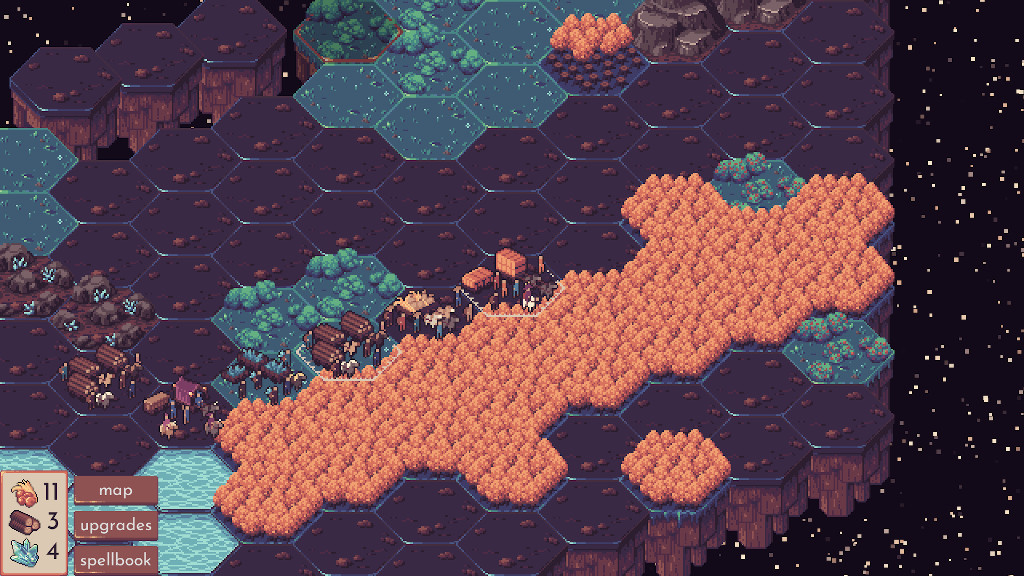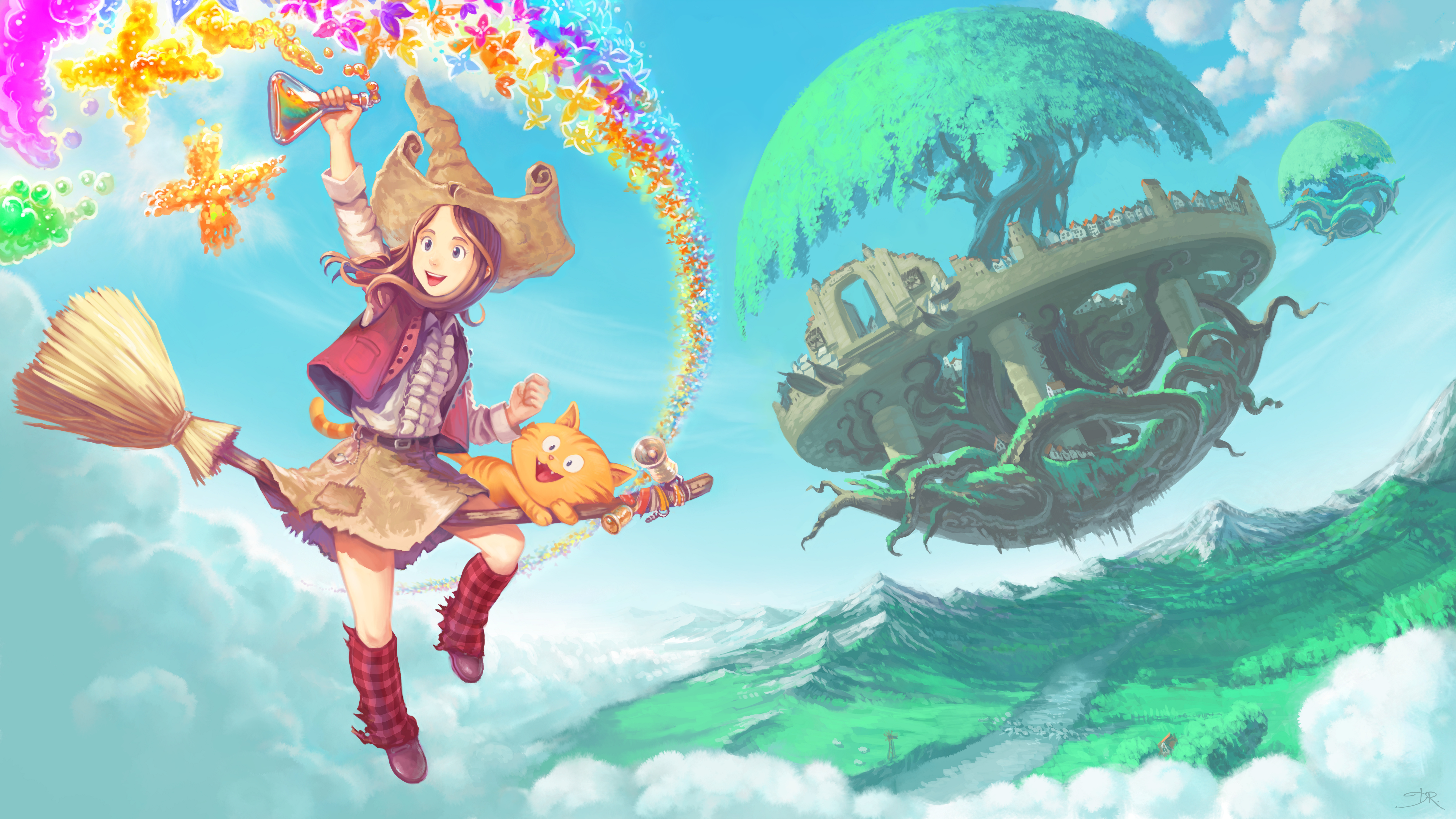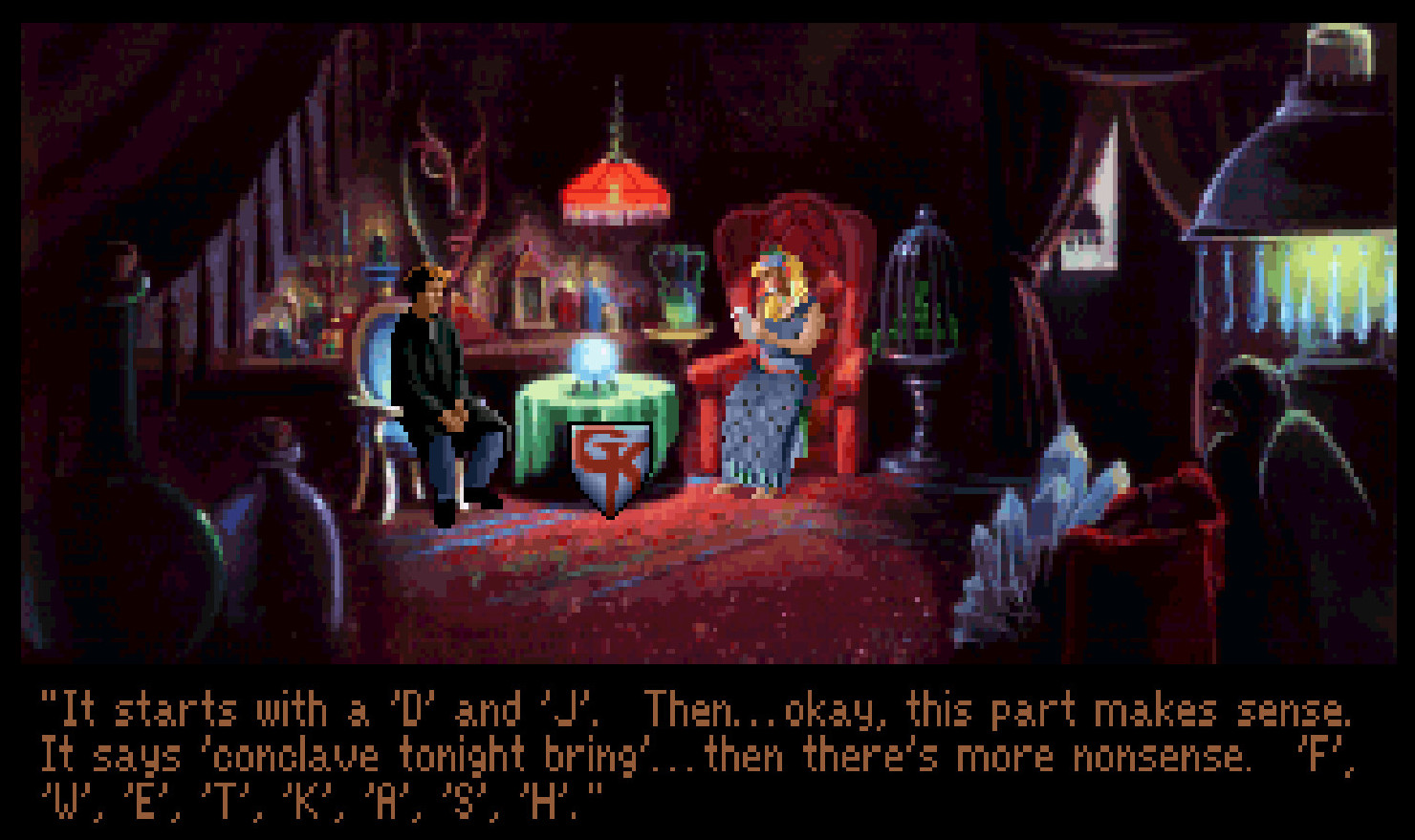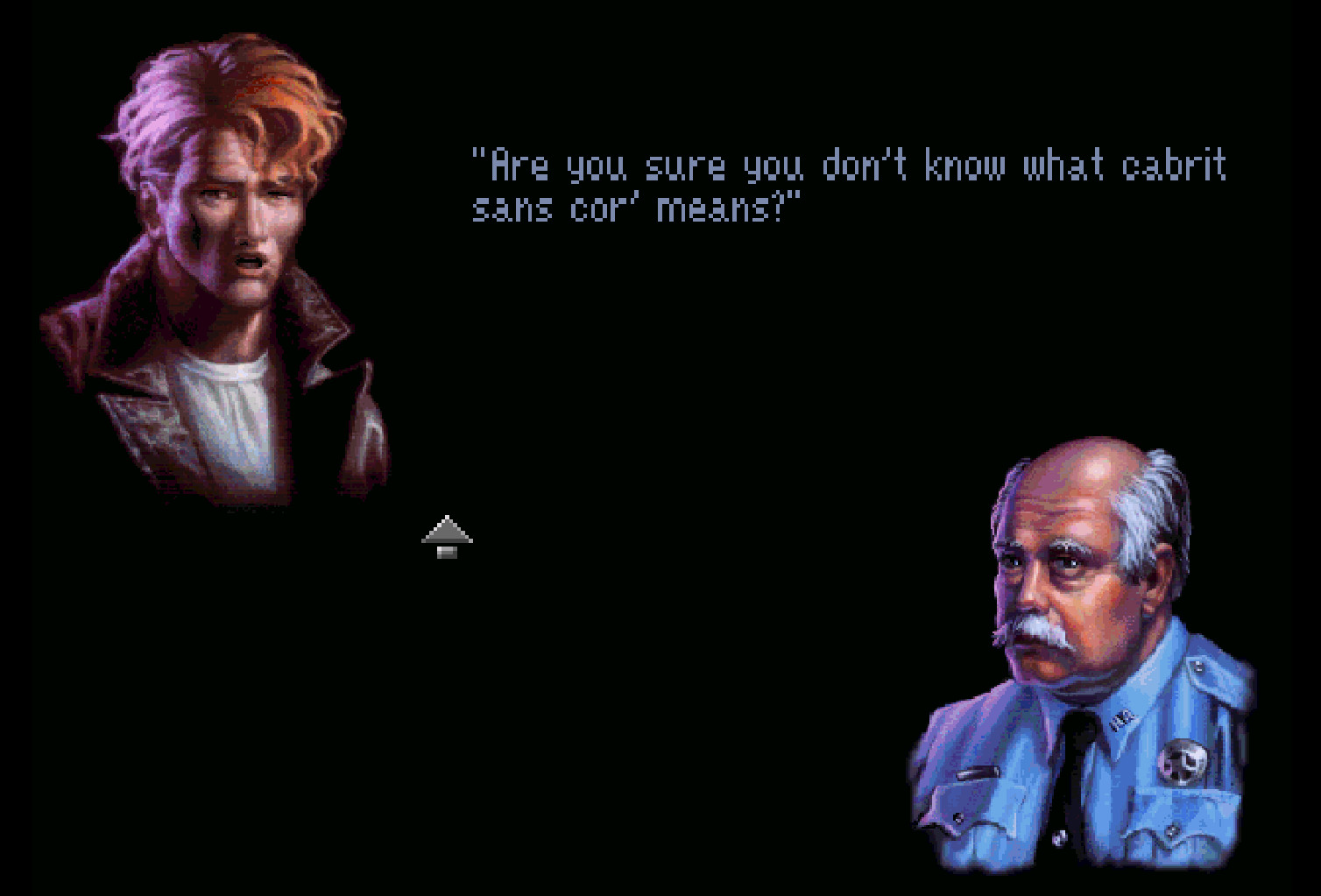Latest reviews
Pretty sweet.
Karawan is a small, free indie game that came out of this year’s Ludum Dare jam. Turn by turn, you guide a growing caravan through a world that is rapidly falling apart, to a portal that will take you to safety.
To make it, you have to carefully plot your path and pay attention to the resources you can gather along the way. If you don’t, you are likely to run out of food, or you may find yourself on a tile that’s about to disintegrate.
As you traverse the map, you can visit various villages, where you can recruit caravan members with different skills: farmers who will harvest berries, woodcutters who will chop down forests, and miners who will collect gemstones.

The first map, Gaia, is fairly straightforward, but you will likely still take a few tries before you make it to safety. (Credit: bippinbits. Fair use.)
You can also choose to raid villages for resources instead. Some of them are protected by a wizard (called a magus), whom you can recruit. The magus is quite powerful, and can even alter the terrain around you.
The game’s stylish pixel art, sparse but evocative descriptions, and the slow, slightly eerie music all draw you in. Don’t let the game’s chill tone fool you: seeing the world disappear behind you will quickly create a sense of urgency for your journey. Karawan may hook you for at least 30-60 minutes, longer if you want to beat all maps. I recommend downloading the slightly improved PostJam version.
The game was made with the open source Godot Engine, and is available for Windows and Linux.
Lange vor meiner Zeit wurde der Vorgänger dieses Stadions als Niedersachsenstadion an gleicher Stelle errichtet und ist seitdem die Heimat des lokalen Fußballvereins, Hannover 96, gewesen. Und das war Anfangs auch mein Grund, öfter mal diese Spielstätte aufzusuchen. Lange Zeit fand ich es sehr schön und unterhaltsam, mir die Heimspiele vor Ort im Stadion anzuschauen. Aber meine Interessen haben sich gewandelt. Zwar immer noch Fußball aber nicht mehr so häufig vor Ort. In letzter Zeit war ich nur noch bei großen Konzerten, Robbie Williams, U2, Rammstein oder Helene Fischer (!).

Vorprogramm zu einem Fußballspiel in der HDI-Arena in Hannover (Eigenes Werk. Lizenz: CC-BY-SA.) Die Anreise zum Stadion gestaltet sich einfach und geht am besten mit dem öffentlichen Nahverkehr in Hannover vonstatten. Die Stadtbahnhaltestellen Stadionbrücke oder Waterloo liegen in fußläufiger Entfernung und werden bei Großveranstaltungen mit Verstärkerzügen angefahren um die Menschenmengen zu entzerren. Am Eingang kommt es bei den Fußballspielen immer wieder zu langen Wartezeiten während der Kontrolle. Nichts schlimmes, aber bei Konzerten läuft dieser Vorgang besser.
Im Stadion gilt der Spruch “Nur Bares ist wahres” schon länger nicht mehr. Getränke und Snacks werden bargeldlos bezahlt. Seit kurzem (07/2021) nicht mehr mit einer speziellen Stadionkarte sondern kontaktlos mit der girocard. Leider ändert auch dies nichts an der Tatsache, das sich an den Getränkeausgaben immer wieder sehr lange Warteschlangen bilden.

Blick auf die Bühne beim Rammstein-Konzert in der HDI-Arena in Hannover (Eigenes Werk. Lizenz: CC-BY-SA.) Hat man dann genug gewartet, bleibt die Auswahl zwischen Softdrinks, Bier und den üblichen Snacks, deftige Stadionkost also. Nichts besonders.
Für mich ist der Funke beim Fußball nicht übergesprungen, mit dem Ort verbinde ich keine Emotionen und bin daher, sofern es Corona zukünftig zulassen sollte, nur noch zu Konzerten vor Ort. Unter diesen Aspekten vergebe daher eigentlich 2,5 Sterne die ich systembedingt aufrunden muss.
The Many Saints of Newark is impeccably acted and provides a much less egregious take on fan service than the usual Han Solo’s Dice prequel fare, but ultimately fails to justify its existence. Its main redeeming quality is that it pays more attention to the effects of organized crime on the black experience – something that was conspicuously absent from the series, and is an encouraging reminder of how we’ve come culturally the last 15 years.
It requires a debrid service, but it’s super easy to use, it can use any IMDB or Trakt lists, etc. It can track all your recent shows and present the new episodes. Very similar to Seren but I prefer it.
As a debrid, they cache popular torrents so you can stream them right away. They also have premium access to many paid streaming sites. Side features include a download manager for premium sites, 1TB cloud with RSS-Torrent support, VPN. It’s like $13 a month, pretty great deal for the features, and the best Kodi apps like Seren or TheOath use it, or similar. Hit me up for a referral link if you want, I’ll get a free month.
You know what, eat your fucking horse paste, we don’t need you around
It’s one of the rare great healthy options in the areas it serves. Flame grilled chicken, steamed veggies, Mexican rice, the only sort of “unhealthy” thing off the top of my head is their great Mac N Cheese. Generally cheap too. I got amazing churros that were obviously freshly made.
Out-of-towners rant about In-N-Out, but they need to try El Pollo Loco too
Mit Pepper&Carrot hat der Autor David Revoy einen tollen Episoden-Comic erschaffen, der unter einer CC-Lizenz im Internet verfügbar ist.

Die beiden namensgebenden Hauptdarsteller im gleichnamigen Comic Pepper&Carrot (Namensnennung: David Revoy. Lizenz: CC-BY.)
In regelmäßig erscheinenden Episoden wird die Geschichte aus einer fiktiven Welt mit Hexen und allerlei anderen Fabelwesen erzählt. Nettes Detail am Rande erwähnt: alle Protagonisten tragen die Namen von Kochzutaten. Wie auch bei der Namensgebung lässt der Autor sehr viele Details in die Zeichnungen einfließen. Es macht einfach Spaß, die kurzen Episoden zu genießen und sich immer wieder freuen, wenn eine neue veröffentlicht wird.
Auf Grund der gewählten Lizenz, mit der das Comic und alles drumherum, von den Hintergrundgrafiken über die verwendeten Werkzeuge bis hin zur Schriftart, kann jedermann auf diesem Comic ein Produkt aufbauen – und dies sogar kommerziell. Rund um Pepper&Carrot ist ein kleines Universum entstanden. Die Homepage ist, wie auch der Comic, in vielen Sprachen verfügbar. Der Autor erstellt den Comic komplett mit freier Software und hat mehrere Videos zu der verwendeten Software erstellt und wie er damit die Comic kreiert.

Erstes Titelbild zu Pepper&Carrot (Namensnennung: David Revoy. Lizenz: CC-BY.)
Pepper&Carrot ist ein kleines Juwel in den weiten des Internets und wird komplett durch Spenden, z.B. bei Liberapay, finanziert.
Gabriel Knight is a lout. He is also the owner of a bookstore in New Orleans’ famous French Quarter, and a struggling novelist researching a spree of apparently voodoo-inspired killings that have gripped the city. Through his friend Frank Mosely, a police detective investigating the killings, he is able to learn more about the case than what’s reported in the papers.
As he travels the city and speaks to people who may be able to shed light on the case, his shop assistant, Grace Nakimura, minds the store, takes messages for Gabriel, and undertakes research on his behalf. Gabriel is a womanizer, and Grace knows him well enough to keep some distance between them.
What could be the setup for a movie or a TV show is in fact the plot of Gabriel Knight: Sins of the Fathers, a 1993 video game designed by Jane Jensen and published by Sierra. The game is fully voice-acted by a cast that includes Tim Curry (Gabriel Knight), Mark Hamill (Frank Mosely), Leah Remini (Grace Nakimura), and Michael Dorn (Dr. John).
You control Gabriel’s actions in typical point and click fashion: click on hotspots on the screen and interact with them using various actions (look, operate, talk to, etc.). As is typical for the genre, you can carry as much stuff with you as you want, and you’ll want to pick up anything you can.

Cut scenes like this one may reveal important clues to the game’s puzzles. (Credit: Sierra On-Line. Fair use.)
Driven by story and dialogue
There are some important ways in which Gabriel Knight sets itself apart from many other games of its era:
-
The game has a narrator, voiced by Virginia Capers with a thick accent, who often inserts her own commentary about Gabriel’s (attempted) actions, and seems to take some delight in his misfortunes.
While other Sierra games have featured narrators, Capers gives the game a unique personality when, for example, she bursts into laughter as you examine an item in Gabriel’s inventory that relates to a near-death experience. -
Dialogue is a central part of the gameplay. There are separate “talk” and “ask” actions. When you talk to a character, Gabriel will usually cycle through a few casual remarks; when you ask them questions, the game switches to a focused dialogue interface in which you can choose subjects to discuss.
Although the dialogue tree grows to a somewhat ridiculous length (you can literally ask anyone you come across what they know about the voodoo murders, or whether they know the meaning of “cabrit sans cor”), the dialogue system is a nice departure from the usually very limiting conversational options of adventure games. -
The plot advances over the course of 10 days, and the locations and possible interactions change over time. As you visit the police station on different days, for example, you will learn about how the case has progressed since you last spoke to detective Mosely.
The game’s sense of time is entirely tied to specific actions of your character. It’s only when you have solved certain puzzles, or asked certain questions, that you can move on to the next day. This can be frustrating, as only the game knows what specific thing you have to do to unblock the flow of time.

Gabriel Knight was one of the first adventure games to utilize higher resolution SVGA graphics, but it did so only in a limited fashion, such as in the dialogue interface. (Credit: Sierra On-Line. Fair use.)
A product of its time
It is a game of its era, something you may be reminded of when you realize that Gabriel can only use landline phones to communicate over long distances. It’s also reflected in the gameplay: To solve many puzzles, it’s advisable to pay careful attention to every line of dialogue.
Adventure games from this time were meant to keep you playing for many, many hours—if you still got stuck, the expensive hint line was waiting to take your call. This being a Sierra game, you can very much die (especially in the second half), so saving the game often is a good idea.
The racial politics of Gabriel Knight are more troubling. While the story incorporates historical facts about Louisiana Voodoo, the increasingly preposterous narrative follows an all too familiar trajectory in which a white hero (Knight) must overcome forces of evil, who happen to be people of color. That it wraps both heroes and villains in a thin veil of moral ambiguity hardly makes this more palatable.
In spite of these flaws, Gabriel Knight deserves recognition as a milestone in video game storytelling techniques, and is still enjoyable to play today. I recommend using the Universal Hint System over a walkthrough, as it will give you more opportunities to discover solutions to puzzles on your own. The soundtrack has held up well, and adds to the game’s atmosphere and character.
A 20th anniversary remake with new graphics—and a wholly different voice cast—was released in 2014. While Gabriel Knight deserves its place in video game history, I’m not sure it needed a remake. There are new stories to tell, and new heroes to play—ones that challenge stereotypes rather than reinforcing them.
